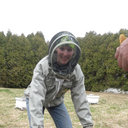Homogeneity among Senegalese strains of yellow fever virus.
Ključne besede
Povzetek
A series of 16 yellow fever (YF) viruses isolated from mosquitoes, monkeys and humans in different epidemiological contexts in Senegal and The Gambia between 1976 and 1983, was analyzed by T1 RNase oligonucleotide fingerprints of the genomic 32P-labeled RNA, by SDS-polyacrylamide gel electrophoresis of the intracellular virus-specified polypeptides, by peptide mapping of the envelope E glycoprotein and by immunological reactivities with monoclonal antibody fluids (MAF's) against the E glycoprotein. These strains had not been passed in suckling mice and were isolated in Aedes pseudoscutellaris Mos 61 cultured cells. These strains showed no virulence in three-week-old Swiss mice when injected intraperitoneally. Direct comparison of the large T1 RNase-resistant oligonucleotide maps indicated a relative genetic stability (92%-100%). A greater change was observed when these strains were compared with an epidemic YF strain isolated in 1965 with an oligonucleotide fingerprint map sharing 82%-88% similarity. The YF-specified proteins were identical in their molecular weight, and the fragments obtained after limited proteolysis of the envelope protein using protease V8 or alphachymotrypsine indicated that the strains were chemically similar. Only a few differences were observed when the strains were seroneutralized with MAF's, but no relation could be made with genetic or biological data. This suggested that the YF virus strains isolated from the same geographic area and during a short period of time had evolved slowly. Moreover, all the viruses were closely related and no correlation could be established with the apparent variations in virulence in nature.


